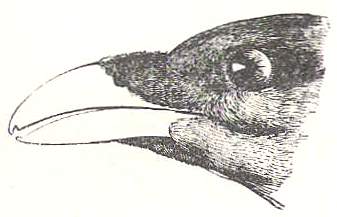|
|
The Bower Bird is Gould's rather poetical name
for some inhabitants of Australia which, while he was in that country he
ascertained, as on his return he announced (25 August, 1840) to the Zoological
Society, to have the extraordinary habit of building what the colonists
commonly called "runs". This discovery seems to have been mainly
due to a Mr. C. Coxen of Brisbane.
|

Picture of Satin Bowerbird (Ptilorhynchus violaceus)
|
"These constructions", Gould correctly said in
the proceeding of the Zoological Society in 1840, "are perfectly anomalous
in the architecture of birds, and consist in a collection of pieces of
stick or grass, formed into a bower; or one of them (that of the Chlamydera
[Western Bower Bird, Chlamydera guttata]) might be called
an avenue, being about three feet in length, and seven or eight inches
broad inside; a transverse section giving the figure of a horse-shoe, the
round part downwards. They are used by the birds as a playing-house or
'run,' as it is termed, and are used by the males to attract the females.
The 'run' of the Satin Bowerbird (Ptilorhynchus
violaceus) is much smaller, being less than one foot in length, and moreover
differs from that just described in being decorated with the highly-coloured
feathers of the Parrot-tribe; the (Chlamydera), on the other hand, collects
around its 'run' a quantity of stones, shells, bleached bones, etc.; they
are also strewed down the centre within."
|
|
There is no reason to suppose that this extraordinary
habit had been described before the date above given, or that the name
"Bower-bird" had been previously used, and yet we find Trelawny in his
Memoirs of Shelley, published in 1878 , referring to himself (i. p. 136)
as saying, in a conversation not later than 1822, "You two have built your
nest after the fashion of the Australian bower-birds.
Gould's statement to the Zooligical society, marvellous
as it seemed, has been proved by many subsequent observers to be strictly
true, and it must be borne in mind that these structures (Gould brought
home with him at least two examples, which he gave to the British Museum),
each of which as above described Gould made drawings of in the following
year (Birds of Australia iv. plates. 8, 10), have nothing to do with nests
of the birds. Indeed, their mode of nidification, which was not made
known until some years later, and the nest itself presents no extraordinary
feature.
Moreover, the birds will build their "bowers" in
confinement, and therein disport themselves, as was repeatedly recorded
by observers of the Satin Bowerbird in the London Zoological Gardens in
the 19th century. Subsequently it was found that the Regent Bower Bird,
Sericulus melinus, a species long before known, had the habit of making
a "bower" of similar kind, though built, so to speak, in another style
of architecture, and having for its chief decoration the shells of a small
species of snail.
|
|
|





